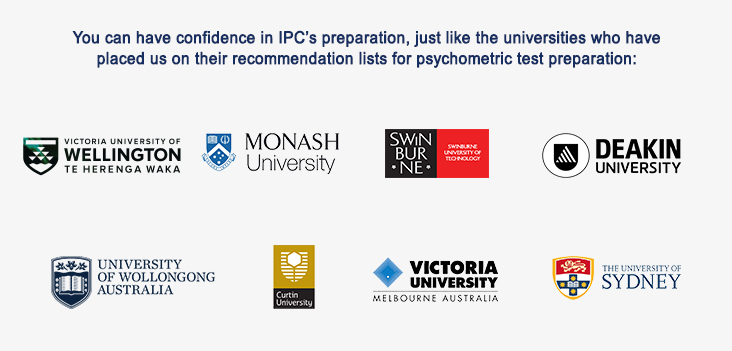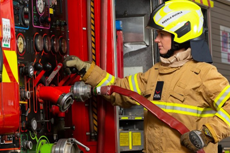Preparing for ACT Fire and Rescue's Aptitude tests & inteviews - timed practice tests with real questions, detailed solutions, online courses & 1-on-1 tutoring
Preparation for ACT Fire & Rescue (ACTF&R) aptitude tests, group activity & Interviews 2025
f you are applying to join ACT Fire and Rescue, you will be required as part of stage 2 of your recruitment process to take several challenging aptitude critical thinking tests managed by TestGorilla:
A timed inductive test (abstarct reasoning test)
A timed deductive test (verbal reasoning test)
A timed numerical reasoning test
What is ACT Fire and Rescue's inductive test (abstract test) by TestGorilla?
As part of your selection with ACT Fire and Rescue you will be asked to complete a timed abstract reasoning test, which which is very different from the type of shapes that you might be used to. This aptitude test takes around 10 minutes to complete.
ACT Fire and Rescue's inductive test (abstract test) timer:
ACT's fire and rescue absttract test is timed. The timer is set for the entire test.
ACT Fire and Rescue's inductive test questions style:
This type of test questions in cognitive ability test measures your abstract skills. In this type of test questions you are presented with a group of shapes or items. Your challenge is to quickly identify one or more patterns among most of the shapes presented. Based on these patterns you can eliminate one or two shapes which do not belong with the others.
Let's review the following example, here we can see a group of shapes. Your task is to find wWhich of the shapes doesn’t belong with the others.

To answer this question we need to find the patterns or logical rules that make up this list of shapes going from left to right. When reviewing the three shapes we can identify the following patterns:
1. Each shape has a half white and half black inner shapes.
2. The black and white inner shapes are mirror image..
3. There is a stick or pole coming out from the centre or point of connection between the black and white inner shapes.
As the odd-one-out is a shape that does not incorporate all three patterns, the first shape is the odd-one-out.
What is ACT Fire and Rescue's deductive test (verbal test)?
ACT Fire and Rescue's verbal reasoning test measures your ability to understand verbal information, think logically about written information, accurately draw logical conclusions, produce written reports, and convey information to others in a clear and simple manner.
ACT Fire and Rescue's deductive test timer
ACT's verbal reasoning test is timed. The timer is set for the entire test. You are given 10 minutes to complete the verbal test.
ACT Fire and Rescue's deductive test questions style
This type of questions in your deductive test measures your verbal reasoning and deductive reasoning skills. Test questions in this section include several styles.
These test questions are designed to measure your ability to identify words that do not belong to a group or find word associations or logical thinking.
Let's check the following deductive test question example:
Which two statements together prove that Tim has a red car?
A. Gil likes Tim's car colour
B. Tim likes fast cars
C. Gil has a fast car
D. Gil likes only red cars
E. Tim's car is not silver
The correct answer is A and D, as if Gill likes only red cars and Gill likes Tim's car colour then Tim's car must be red.
What is ACT Fire and Rescue's numerical reasoning test?
ACT Fire and Rescue's numerical test measures your numerical reasoning skills. The test doesn’t measure your skills in maths but your ability to quickly and logically process numerical information.
The numerical reasoning test timer:
ACT Fire and Rescue's numerical reasoning test is timed. The timer is set for the entire test. You are given 10 minutes to complete the numerical test.
The numerical reasoning test questions style
There are several types of numerical reasoning test questions in ACTF&R's numerical test.
Example numerical question 1:
Tom has been flying his small jet for 30 minutes and has travelled 200 km. What has been his average speed in Kilometres per hour?
This is a time, speed, distance type of test question. To solve this question you must use the formula time x speed = distance. Based on the question time = 0.5 of an hour and distance = 200 km, Therefore, the speed is 200/0.5 = 400 km/hr
Example numerical question 2:
Steve has to figure out the number of animals to be placed in each of the small zoo's cages. He decided that the number of animals to be placed in each of the 6 cages will depend on the size of the cage in comparison to the other cages. One cage is four times the size of two of the zoo's cages and equal to the three other cages. What is the minimum number of animals in each cage?
This is a question that that requires you to represent verbal information in numerical format. Based on the information in the question, if X represents the number of animals in a small cage then 2X represents the number of animals in the bigger cage. Based on the information in the question, we can conclude that there are 4 big cages and 2 small ones. To find the smallest number of animals in each cage is 1 in the small cage and 2 in the bigger cage. The smallest number of animals in all 6 cages is 2+2+2+2+1+1= 10.
ACT Fire & Rescue group activity
What is measured in a group activity?
- Your ability to influence others.
- Your level of involvement in performing a group task.
- Your communication style - are you kind, aggressive, dominant, controlling, accommodating, listening when interacting with others?
- The quality of your contribution to the team.
How are you measured in a group activity?
Your individual and others style of interaction during the entire group activity are observed and assessed by qualified observers who are typically psychologists or people with special qualifications.
The group activity is used as an opportunity to measure your ability to work and interact with others such as your communication skills, listening skills, influencing skills, negotiating skills, social confidence, ability to encourage others, decision making skills.
The actual group activity has little importance to the measurement of your skills. It is merely used as a background or a trigger to create a group interaction between you and other participants.
What are good qualities to demonstrate in a group activity?
If you are capable of influencing others in a group activity, show capability to listen to others, contribute to the group effort and offer constructive ideas you are likely to be tagged as a suitable candidate for managerial roles.
If you demonstrate good social skills, you are considerate but you are lacking decisiveness and ability to influence others then you are likely to be tagged as a less suitable candidate for a managerial role but might be suitable for positions that require team work or cooperation with others and less managerial substance.
If you demonstrate a dominant behaviour by taking control over the activity, you don’t listen to others, you don’t encourage others’ contribution and are less considerate to others then you are less likely to be suitable for a position that requires team work.
Is the quality of the group outcome important?
One of the common mistakes is to assume that an assessment centre measures the team’s behaviour and outcome. In other words, has the team achieved its goals or objectives. However, the observation is not focused on the outcome. It is only focused on measuring your behaviour in the team. The atmosphere in the team and the quality of its outcome have no impact in a group assessment.
What are the challenges of a group activity?
An unknown group activity and the need to manage group dynamics are factors that often lead participants to an excessive sense of stress. This type of test is especially more difficult and challenging for people who are more introverted and less socially confident.
Most of us need some time to adjust and feel comfortable and confident in a new situation and new people. Some of us need more time to get comfortable and others need less. However, a group activity exercise offers us no time to adjust but requires you to respond immediately to a problem which is presented to the group members. People’s response to such a situation can be very different:
- Some become quiet and close up.
- Some become aggressive and dominant.
- Some feel very comfortable almost like a fish in the water.
Becoming quiet and closed up
This style of negative communication in a group activity is typically characterised by the following behaviours:
- Sitting quietly through the activity, as you feel scared to take part.
- Sitting and watching others take control.
- Rarely (if the group is fairly quiet) trying to express your view but this is done in a low and hesitant voice so it gets little attention from the group.
Aggressive and dominant behaviour
This style of negative communication in a group activity is typically characterised by the following behaviours:
- Over need to take control over group activity.
- Excessive involvement and need to influence every decision.
- A tendency to dictate to others what to do.
- A lack of interest to listen to others or encourage others to express their opinion.
Feeling socially comfortable
This positive style of communication in a group activity is typically characterised by the following behaviours:
- An interest to listen to others’ opinions.
- An ability to persuade others in a kind and friendly way.
- A friendly demeanour when interacting with others such as smiling, approaching people by their names and showing positiveness.
Our Professional Preparations for your aptitude tests, group activity & Interviews with ACT Fire & Rescue:
The Institute of Psychometric Coaching has developed a variety of tailored preparations to ensure you are ready for your tests with ACT Fire and Rescue.
Our professional preparations include:
1. Practice aptitude tests online customised for ACT Fire & Rescue:
- A large pool of timed practice aptitude tests with timers and detailed answer explanations.
- Based on similar TestGorilla test questions.
- Timer mimics the pressure of taking the real test.
- Step by step solutions at the end of each aptitude test.
- Test scores in comparison to others.
- Feedback on how to improve.
- Immediate Access.
2. Aptitude test courses online for ACT Fire & Rescue:
- Special aptitude tests' courses online with all the knowledge you need to pass ACT Fire & Rescue's tests.
- Abstract Test Course online with some example test questions.
- Verbal Test Course online with some example test questions.
- Numerical Test Course with some example test questions.
- Immediate Access.
3. 1-on-1 coaching for your aptitude tests, group activity and behavioural interview with ACT Fire & Rescue:
- Delivered by expert Psychometricians who are experienced with ACT fire and rescue aptitude tests.
- Face to face or via Teams live.
- Includes special material, techniques and guidance how to solve ACT Fire & Rescue aptitude test questions.
- Applying with you the techniques and guidelines to example aptitude test questions for ACT fire & Rescue to ensure that you know how to solve these questions.
- Working with you how to shine in the group activity. including simulations and real feedback.
- Working with you to ensure you demonstrate your full potential and capabilities in ACT Fire & Rescue's group activity and behavioural interview.
- Working with you to prepare you for the behavioural questions for ACT fire & rescue's interview.
- Special simulations and real time feedback for your interview.










